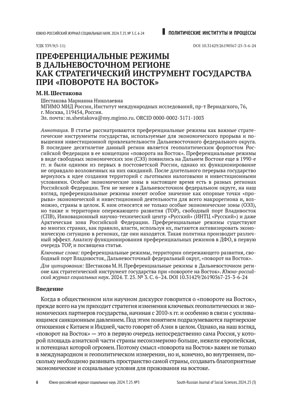Abstract
The article analyses preferential regimes as a significant strategic instrument employed by the state for economic advancement and enhancing the investment appeal of the Far Eastern Federal District. Over the past decade, this region has served as a geopolitical outpost of the Russian Federation in accordance with its ‘turn to the East’ strategy. Preferential regimes in the form of free economic zones (FEZs) appeared in the Far East back in the 1990s and were among the first in post-Soviet Russia. However, the efficacy of these regimes has not met expectations. After an extended break, the state resumed its attempts of establishing territories offering advantageous fiscal and investment climates. Nowadays, special economic zones are in operation in a number of regions within the Russian Federation. Nevertheless, preferential regimes play a special role in the Far Eastern Federal District, serving as pivotal reference points for ‘breakthrough’ economic and investment activity across the entire macro-region and potentially the country as a whole. These include not only special economic zones (SEZs), but also advanced development territories (ADTs), the Free Port of Vladivostok (FPV), the Innovation Science and Technology Centre ‘Russkiy’ (ISTC ‘Russkiy’) and even the Arctic Zone of the Russian Federation. It is common practice for governments in many countries to implement preferential economic policies with the objective of stimulating economic growth in specific regions. Such policies produce varying effects. This article presents an analysis of the functioning of preferential regimes in the Far Eastern Federal District, with a particular focus on ASEZ.
Keywords
References
Бакланов, П.Я., Романов, Р.Т. (2019). Направления долгосрочного развития Дальневосточного региона России. Вестник ДВО РАН, 4, 6–18. DOI: 10.25808/08697698.2019.206.4.001
Ващук, А.С., Воронцов, Н.С. (2022). Дальневосточный фронтир 1990‑х годов: от «территории-крепости» к новым формам развития региона. Журнал фронтирных исследований, 4, 104–135. DOI: 10.46539/jfs.v7i4.309
Гагарина, Г.Ю., Антонова, Д.А. (2023). Возможности заимствования Российской Федерацией мирового опыта преференциальных режимов. Федерализм, 28(3), 29–48. DOI: 10.21686/2073-1051-2023-3-29-48
Гулидов, Р.В. (2021). К вопросу об оценке государственной политики по развитию Дальнего Востока России. Пространственная экономика, 17(4), 143–167. DOI: 10.21686/2073-1051-2023-3-29-48
Квашнина, И.А. (2021). Особые экономические зоны как инструмент привлечения иностранных инвестиций. Вестник Института экономики Российской академии наук, 3, 121–132. DOI: 10.52180/2073-6487_2021_3_121_132
Котов, А.В. (2023). Особенности регулирования преференциальных территориальных режимов в странах ЕС. Современная Европа, 1, 100–112. DOI: 10.31857/S0201708323010084
Кузнецова, О.В. (2018). «Восточный вектор» инвестиционных связей России. Мировая экономика и международные отношения, 62(2), 47–56. DOI: 10.20542/0131-2227-2018-62-2-47-56
Кузнецова, О.В. (2020). География особых экономических зон и их аналогов в России. Региональные исследования, 4(70), 19–31. DOI: 10.5922/1994-5280-2020-4-2
Кузнецова, О.В. (2016). Особые экономические зоны: эффективны или нет? Пространственная экономика, 4, 129–152. DOI: 10.14530/se.2016.4.129-152
Кузнецова, О.В. (2019). Стратегия пространственного развития Российской Федерации: иллюзия решений и реальность проблем. Пространственная экономика, 15(4), 107–125. https://dx.doi.org/10.14530/se.2019.4.107–125
Лексин, В.Н. (2019). Дороги, которые мы не выбираем (о правительственной «Стратегии пространственного развития Российской Федерации на период до 2025 года»). Российский экономический журнал, 3, 3–24. DOI: 10.33983/0130-9757-2019-3-3-24
Леонов, С.Н. (2017). Инструменты реализации государственной региональной политики в отношении Дальнего Востока России. Пространственная экономика, 2, 41–67. DOI: 10.14530/se.2017.2.041-067
Леонов, С.Н. (2020). Преференциальные режимы созданных локальных точек роста и их влияние на экономику Дальнего Востока. Экономические и социальные перемены: факты, тенденции, прогноз, 13(3), 28–45. DOI: 10.15838/esc.2020.3.69.3
Ломакина, Н.В. (2018). Государственное стимулирование инвестиций в минерально-сырьевые проекты: дальневосточный вариант. Регионалистика, 5(4), 14–23. DOI: 10.14530/reg.2018.4.14
Ломакина, Н.В. (2020). Государственное стимулирование инвестиционной активности в ресурсном регионе: Дальневосточный вариант. Пространственная экономика, 16(4), 68–90. DOI: 10.14530/se.2020.4.068-090
Минакир, П.А. (2017). Ожидания и реалии политики «поворота на Восток». Экономика региона, 13(4), 1016–1029. DOI: 10.17059/2017-4-4
Минакир, П.А. (2012). О концепции долгосрочного развития экономики макрорегиона: Дальний Восток. Пространственная экономика, 1, 7–28.
Одинцова, А.В. (2023). Преференциальные территории в пространственном развитии Российской Федерации. Федерализм, 28(2), 27–46. DOI: 10.21686/2073-1051-2023-2-27-46
Печерица, В.Ф. (2013). Свободные экономические зоны КНР — локомотивы китайской экономики: опыт для России. Таможенная политика России на Дальнем Востоке, 2(63), 99–104.
Смородинская, Н., Капустин, А. (1994). Свободные экономические зоны: мировой опыт и российские перспективы. Вопросы экономики, 12, 126–140.
Смородинская, Н.В. (2011). Организация особых экономических зон в мировой и российской практике: концептуальные аспекты. Вестник ИЭ РАН, 3, 16–36.
Швецов, А.Н. (2015). Особые правовые режимы для привлечения частных инвестиций и современных технологий в развитие территорий. Проблемный анализ и государственно-управленческое проектирование, 4, 49–63.
Шеховцов, А., Шестакова, М., Громов, А. (2000). Свободные экономические зоны: мировой опыт и перспективы в России. Вопросы экономики, 10, 104–117.
Bach, J. (2011). Modernity and the Urban Imagination in Economic Zones. Theory, Culture & Society, 28(5), 98–122.
Bost, F. (2019). Special Economic Zones: Methodological Issues and Definition. Transnational Corporations Journal, 26(2), 141–156.
Chen X. (1994). The Changing Roles of free Economic Zones in Development: A comparative Analysis of Capitalist and Socialist Cases in East Asia. Studies in Comparative International Development, 3–25.
Chen X. (1995). The Evolution of free Economic Zones and the Recent Development of Cross-national Growth Zones. International Journal of Urban and Regional Research, 4, 593–621.
Farole T. (Ed.). (2011). Special Economic Zones: Progress, Emerging Challenges, and Future Directions. World Bank Publications.
Grubel H.G. (1982). Towards a Theory of free Economic Zones. Weltwirtschaftliches Archiv, 118(1), 39–61.
Krugman P. (1991). The Move toward free Trade Zones. Economic Review, 76(6), 5.
Levien M. (2012). The Land Question: Special Economic Zones and the Political Economy of Dispossession in India. The Journal of Peasant Studies, 39(3–4), 933–969.
Meng G. (2005). Evolutionary Model of Free Economic Zones: Different Generations and Structural Features. Chinese geographical Science, 15, 103–112.
Papadopoulos N. (1987). The Role of Free Zones in International Strategy. European Management Journal, 5(2), 112–120.
Shuhong G. (2012). Evolution of Development of Free Economic Zones in China. Journal of European Economy, 11(2), 184–192.
Wong K.Y., Chu D.K.Y. (1984). Export Processing Zones and Special Economic Zones as Generators of Economic Development: The Asian Experience. Geografiska Annaler. Series B. Human Geography, 1, 1–16.
Zeng D.Z. (2016). Special Economic Zones: Lessons from the Global Experience. PEDL Synthesis Paper Series, 1(1), 1–9.


